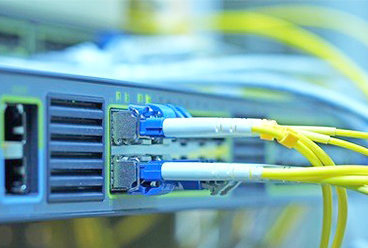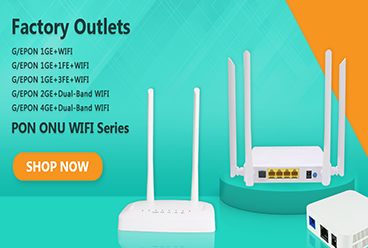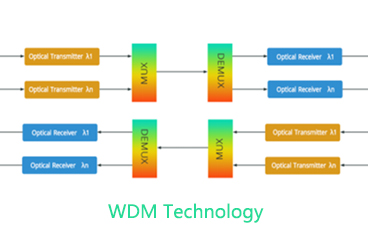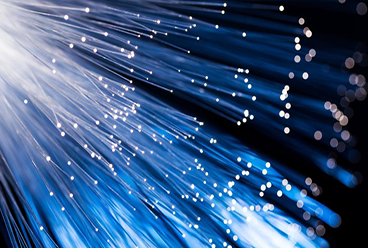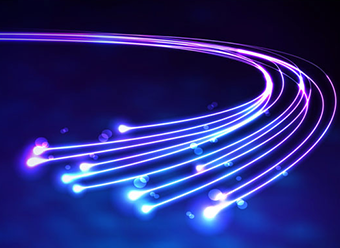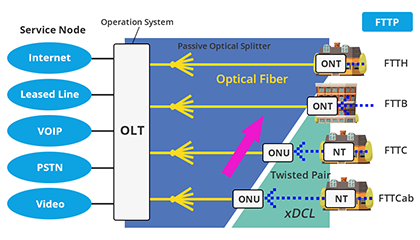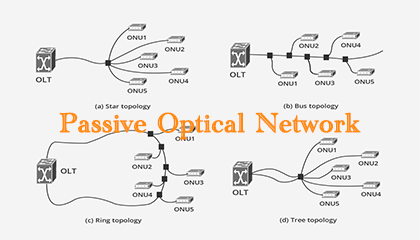The optical fiber connector ONU mainly in two ways, one is in the form of topological point (Point to Point, P2P), from the central office to each user with an optical fiber;The other is Passive Optical Network (PON) that uses Point to Multi-Point (P2MP) topology.
For an unprotected FTTx system with N end users at a distance of M km, if a point-to-point solution is adopted, 2N optical transceivers and NM km of optical fiber are required. However, if a point-to-multipoint solution is adopted, N eleven optical transceivers, one or more (depending on the size of N) optical splitters, and approximately M km of optical fiber are required. At this point, point-to-multipoint The multi-point solution greatly reduces the number of optical transceivers and fiber usage, and reduces the rack space required by the central office, which has obvious cost advantages.
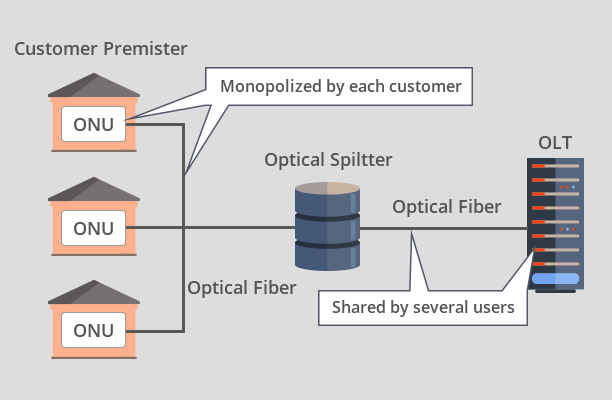
1. Point-to-point FTTx solution
Point-to-point direct optical fiber connection has the advantages of easy management, no complicated uplink synchronization technology, and automatic terminal identification. In addition, all the upstream bandwidth can be used by one terminal, which is very conducive to bandwidth expansion. But these advantages cannot offset its disadvantages in terms of device and fiber cost.
Ethernet + Media Converter is a transitional point-to-point FTTH solution. This solution uses Media Converter (MC) to convert electrical signals into optical signals for long-distance transmission. Among them, MC is a simple photoelectric/electro-optical converter, it does not process the signal packet, so the cost is low. The advantage of this scheme is that it only needs to add MC to the existing electrical Ethernet equipment.For the currently popular 100 Mbps Ethernet network, the speed of 100 Mbps can also meet the needs of the access network. There is no need to replace the network card that supports optical fiber transmission. Only the MC is required, so that users can reduce the cost of upgrading. It is a point-to-point FTTH Network solutions during the transition period.Because its technical architecture is quite simple, cheap and directly integrated with the Ethernet network, it once became the mainstream of FTTH in Japan.
However, in the 2004 OFC meeting, NTT announced that from now on, the Japanese FTTH bid will adopt a Point to Multi-Point (P2MP) PON network model, which will inevitably affect the future of MC.

In the optical access network, if the optical distribution network (ODN) is all composed of passive devices and does not include any active nodes, then this optical access network is a PON.The PON architecture is mainly based on the optical signal downstream from the optical fiber line terminal equipment OLT, through an optical fiber through the passive device Splitter (optical splitter), the optical signal is split and broadcast to each user terminal equipment ONU/T, so that Significantly reduce the cost of network equipment room and equipment maintenance, and save a lot of optical cable resources and other construction costs, so PON has become the latest popular technology for FTTH.PON technology began in the early 1980s. According to the technology used, PON products on the market are mainly divided into APON/BPON (ATM PON/Broadband PON), EPON (Ethernet PON) and GPON (Gigabit PON) Among them, GPON is the latest standardized and commercialized technology. Different PON technologies have different advantages and disadvantages, as shown in the following table.
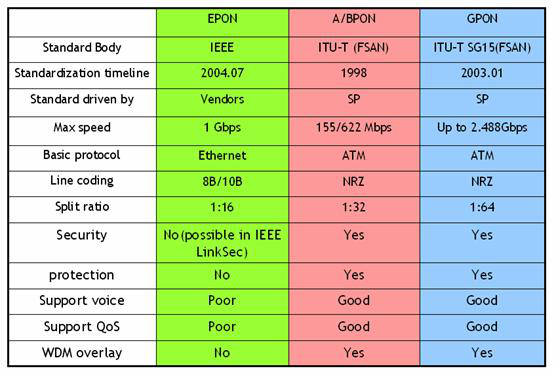
As a kind of access network technology, PON is positioned in what is often called the "last mile", that is, a solution between service providers, telecommunication bureaus, and commercial users or home users.With more and more broadband applications, especially the rise of video and end-to-end applications, people's demand for bandwidth has become stronger and stronger. In North America, the bandwidth demand of each user will reach 20-50Mb/s within 5 years, and will reach 70Mb/s within 10 years. With such a high bandwidth demand, traditional technology will not be able to do the job, but PON technology can show its talents.
In the field of LAN, Ethernet technology high-speed development. Ethernet has developed into a widely accepted standard. There are now more than 4 million Ethernet ports worldwide, and 95% of LANs use Ethernet technology. The Ethernet technology has developed rapidly, and the transmission rate has increased from 10 Mbit/s, 100 Mbit/s to 1000 Mbit/s, 10 Gbit/s or even 40 Gbit/s, which has increased by orders of magnitude; the application environment has also evolved from LAN to MAN and core network.
EPON was proposed by the EFM (Ethernet in the First Mile) research group established by the IEEE 802.3 working group in November 2000. EPON is a combination of several best technologies and network structures. EPON uses Ethernet as the carrier, adopts a point-to-multipoint structure and passive optical fiber transmission. The downstream rate can currently reach 10 Gbit/s, and the upstream sends data streams in bursts of Ethernet packets. In addition, EPON also provides certain operations, maintenance and management (OAM) functions.EPON technology has good compatibility with existing equipment. And EPON can easily achieve a smooth upgrade of bandwidth to 10 Gbit/s. Development of new quality of service (QoS) technology allows Ethernet support for voice, data and video services possible. These techniques include full-duplex support, priority (p802.1p) and virtual local area network (VLAN). However, the current Ethernet standard for supporting multiple services has not yet formed, and it cannot support non-data services, especially TDM services. In addition, compared with GPON, its transmission efficiency is lower.
In 2001, the FSAN group started another standard work aimed at standardizing PON networks with operating speeds higher than 1Gbit/s. This work is called Gigabit PON (GPON). In addition to supporting higher speeds, GPON also supports multiple services with high efficiency, providing abundant OAM&P functions and good scalability. Representatives of operators in most advanced countries put forward a set of "Gigabit Service Requirements" (GSR) documents as one of the standards submitted to ITU-T; in turn, they became the basis for proposing and developing GPON solutions. This shows that GPON is a solution designed according to the exact needs of consumers and driven by operators, and is worthy of the trust of product users.
2. Optical fiber circuit classification
FTTx is divided into three categories in the design of the transmission layer, namely Duplex dual-fiber bidirectional loop, Simplex single-fiber bidirectional loop and Triplex single-fiber three-way loop. The dual-fiber loop uses two optical fiber connections between the OLT end and the ONU end, one is Downstream, and the signal is from the OLT end to the ONU end; the other is Upstream, and the signal is from the ONU end to the OLT end. Simplex single-fiber loop is also called Bidirectional, or BIDI for short. This solution uses only one optical fiber to connect the OLT end and the ONU end, and uses WDM to transmit upstream and downstream signals with optical signals of different wavelengths. Compared with Duplex dual-fiber circuits, this single-fiber circuit using WDM transmission can reduce the amount of fiber used by half, which can reduce the cost of ONU user end. However, when using single-fiber transmission, a light splitting and combining unit should be introduced in the optical transceiver module. The architecture is a little more complicated than the optical transceiver module using the dual-fiber method. The BIDI upstream signal uses the laser transmission in the 1260 to 1360 nm band, and the downstream uses the 1480 to 1580 nm band. In the dual-fiber loop, both the upstream and downstream use the 1310 nm band to transmit signals.

Related articles : PON + EOC Fiber Optical Network Solutions
Tags : FTTx , FTTH , Fiber solutions , GPON , EPON
— END —




